- Walking Dead Saints and Sinners Best Weapons - July 31, 2023
- Pistol Whip Style Guide - June 8, 2023
- Bonelab Best Mods: Our Top 16 - February 15, 2023
I certainly didn’t think I’d be penning a review for a new Half-Life game in 2020, and I’ve enjoyed every chance I’ve gotten to talk about the series since. I needn’t tell anyone what Half-Life: Alyx meant to fans of the series — those who had patiently waited for a new entry for so long that the series had garnered its own microcosmic culture of memes and jokes.
To be a VR fan, eagerly awaiting the platform to take off under the supposed rocket fuel of the AAA industry, as well as a Half-Life fan? Let’s just say I don’t think there’s ever been a title I’ve been more excited for.
And, thankfully, the game was everything I’d hoped an AAA, VR Half-Life experience would be: another masterpiece in interactive entertainment with a thrilling story (and unbelievable ending), jaw-dropping, never before achieved visuals on the platform, and unprecedentedly detailed, tactile environments to explore.
They even managed to make the experience beginner-friendly through expertly dialed-in mechanics — nothing felt awkward or difficult, and ultimately, Valve did what they do best (when they finally got around to it): they innovated.
If this is your first time playing the game, though, you’ll do well to have some pointers. As someone intimately familiar with the series’ world, lore, and game mechanics, and as someone who’s been using VR for many years, I jumped at the opportunity to write this overview.
This is an expansive game in a big series, so in this write-up, I’ll go over a brief history of the game and the series as a whole, give a character bio, and explain the things you need to know to get the most out of the gameplay.
Bottom Line Up Front
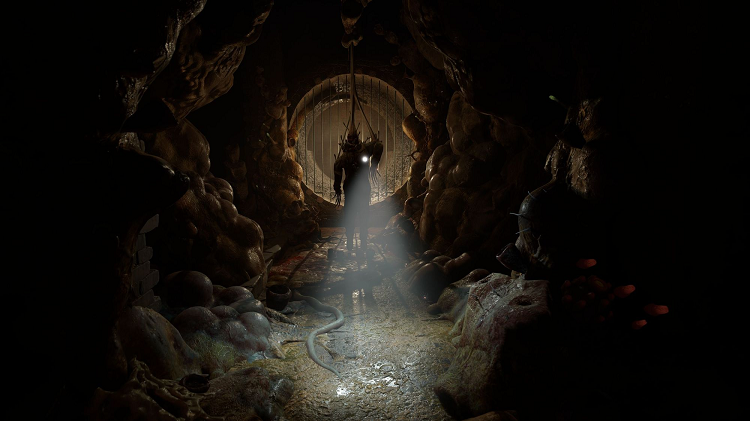
For those new to the series, or even old fans (especially considering how long they’ve been waiting!), things can be a little confusing at first. The aim of this article is to boil the basics down into digestible chunks; other articles on the site will explore the nitty-gritty in greater detail.
Whether it be the new mechanics, the complex lore, or even the somewhat overwhelming nature of navigating such a detailed, realistic world, my aim with this guide is to provide you with some support so that you can get the most out of your initial time with the game. The idea is that you can easily refer to and digest a section with modularity if you get stuck.
I’ve ensured that all of the core elements are covered so that if you hit a wall, you’re able to quickly find what you’re looking for in the guide to progress. This guide covers the story, movement mechanics, weapons, enemies, main characters, puzzles, combat, and upgrades.
For many, this is also their first time in the Half-Life universe, so the sections below have been written to reflect that. In that vein, the following section provides a brief overview of the series as a whole.
Half-Life: the Poster Boy for the Evolution of Video Game Technology
Valve CEO Gabe Newell has long claimed that the company uses Half-Life games to push the industry forward into new, uncharted territory, and it’s hard to argue with that claim.
The first game in the series, released in 1998 for PC, showed the world that interactive storytelling, through a sublime implementation of world-building and linearity, had a place in the shoot-first-ask-questions-latter ethos of the first-person shooter.
DOOM designer John Carmack famously once said, “Story in a video game is like story in a p*rn movie — it’s expected to be there, but it’s not important“, but I think it’s safe to say Valve proved him wrong.
The original game weaved a complex, twisting narrative surrounding the series’ titular protagonist Gordon Freeman — a theoretical physicist befallen by a particularly bad day at work at the secret Black Mesa Research facility.
The game was a smashing success: the shooting was great, the level design impactful, the overall experience sublime. It would be matched only by its sequel, Half-Life 2, which was released in 2004.
Following in the footsteps of its predecessor with its tightly crafted balance between solid shooting and a compelling, ever-curveball-throwing story, Half-Life 2 also introduced the world to the joy of physics and realistically animated faces.
The game was chock-full of clever physics puzzles, and through the use of the gravity gun, it enabled the player to intuitively — and gleefully — launch almost any item in the environment at their enemies. The game was followed up by the equally well-received Episodes 1 and 2.
These were stand-alone DLCs, and they were the company’s ill-experiment with episodic content — great games, but the seal on the proverbial cryogenesis of the series.
Valve had planned to create future Half-Life experiences utilizing this new model, but Episode 3 never happened. The series entered a perpetual state of dormancy right up until the announcement of a new game in 2020.
The reveal came in light of the release of Valve’s new VR HMD: Index. The index was, and presently still is, the most feature-rich VR headset on the market, and shortly after proclaiming to be developing a new killer app for the platform, the company announced that piece of software would come in the form of a new Half-life title.
The trailer was jaw-dropping in a multitude of ways, but from a technical standpoint, no one could believe what they were seeing. It looked like the VR experience we’d all been waiting for.
The game received critical acclaim and spawned a whole new wave of Half-Life fans. It’s safe to say Gabe Newell’s comments rang true yet again, because Half-Life: Alyx is the most advanced VR title to date. Let’s get you started with it!
Story
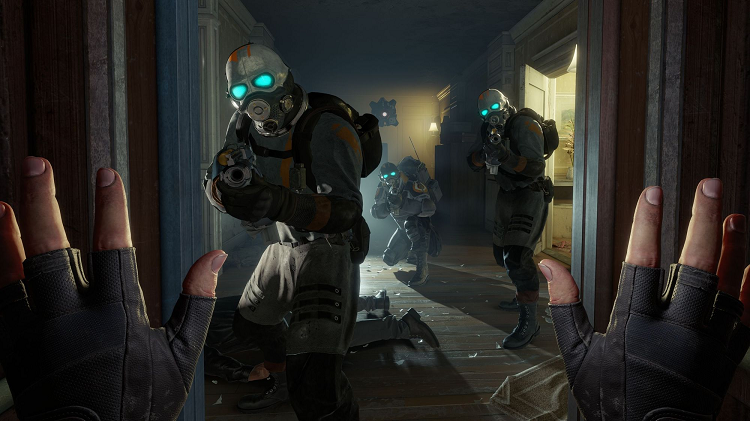
I’ll only provide a brief introduction to the story here so as not to spoil anything.
Like Half-Life 2, this game is set in the fictional, Eastern urban area of City 17 — one of hundreds of human cities reduced to the same numerical system under the tyranny of the Combine. The story takes place five years before the events of the second game and follows Alyx on her quest to rescue her father, Eli, from his untimely capture.
Of course, things do get far more complex than that, but those are aspects I’ll leave you to discover on your own!
Mechanics
The biggest hurdle you’ll need to get over as a new player are the game mechanics — irrespective of whether you’re a VR veteran or a newbie. Thankfully, things are super intuitive; Valve spent years working out VR’s most pervasive problems making for what is a smooth, glitch-free, natural experience.
Movement
The initial consideration is how to traverse the game world. The game allows for both teleportation — whereby you use a cursor to teleport Alyx to the desired location — or full locomotion — the ability to navigate the world with both analogue sticks as you would a traditional first-person game.
It goes without saying the former is targeted towards beginners while the latter is aimed at advanced users, but either camp can learn to use and enjoy both.
Your preferences can be set in the main menu settings, and you can also change the right analogue stick’s camera to perform in a segmented fashion or to smoothly turn continuously. The former may help with motion sickness, while the latter provides a more natural and immersive camera control.
There are no sprint controls as Valve didn’t like the way it felt when they tried to implement it, nor is there a jump button. Any scenario where you would need to jump or vault a ledge is indicated in front of the player, and a press of a button executes the moment.
There are also scenarios where the player will be required to climb a ladder, which is performed intuitively by mimicking the motion as you would in real life.
The Gravity Gloves
One of the most fun (and essential) tools of Half-Life 2 was the Gravity Gun, and Alyx has a very similar ability through the use of Russell’s invention, the Gravity Gloves.
With a quick flick of the wrist, the gloves enable the player to fling almost any holdable item into the player’s hands. Most objects can be held at different positions allowing for incredibly detailed examinations.
If the player has the Valve Index and Knuckles controllers, they will be able to control each of Alyx’s fingers. All other headset controllers allow for the thumb, index finger, and three fingers to be controlled as separate entities — you’ll use these grip mechanics to open doors and draws.
Menus are also intuitively displayed from the player’s hands. Clicking the right stick illuminates your inventory, and if you hover one hand near the other, you’ll also find you have extra space to store items here.
Picking up an item, hovering it over the inventory slot on your wrist, and then letting go, will enable you to temporarily store an item. You’ll also use your hands to reach behind you to grab new clips for your weapons.
Weapons
Weapons are all of the one-handed variety. Valve’s developers thought two-handed designs felt clunky, so even the game’s shotgun presents as a neatly compressed, one-handed firearm.
Notably, there are no melee weapons in the game. Valve apparently couldn’t get melee to work to the level of satisfaction they desired, so they decided to omit them from the game entirely.
There are not many weapons in the game, but was is there represents an essentialized arsenal.
- Pistol: a semi-automatic handgun given to Alyx by Russel.
- Shotgun: a compact, yet powerful one-handed close-range weapon.
- Assault rifle: Offing large damage output at all ranges, the assault rifle is one of the most versatile weapons.
- Frag grenade: An explosive ordinance that makes quick work a group of enemies.
- Xen grenade: A slightly less powerful grenade than the frags but replenishable at Xen flora dispensers.
- Explosive barrels: Red oil canisters that cause an explosion when shot. They can be manoeuvred into place for a tactical attack on multiple enemies.
Other Usable Items
Aside from your weapons, you’ll also use a number of other important items on your travels:
- Grub medkit: The med kits in this game function as rather disgusting live grubs, that are crushed and subsequently inserted into a combine healing station to be utilised. They are found throughout the game world and can be held on your person — saved for when you come across a healing station.
- Med syringe: These items present as something akin to an epi-pen: they contain a fluorescent blue liquid, and the player takes one and stabs it anywhere on their body for a quick health boost. They can only be used once.
- Alyx’s multitool: We saw Alyx routinely use this gadget in Half-Life 2 to get her and Gordon out of a number of life-or-death situations, and it features as an essential tool in this game, too. It’s mostly used for hacking into computer systems where it’s used to solve a puzzle to access an item, or for locating wires in a wall to alternate the current and open an initially locked door.
- Flashlight: A wrist-mounted flashlight that enables the player to illuminate dark environments whilst still being able to use weapons.
- Batteries: Relatively large, storable power sources that are needed to power static electrical equipment used to progress in a level.
Resin and Upgrades
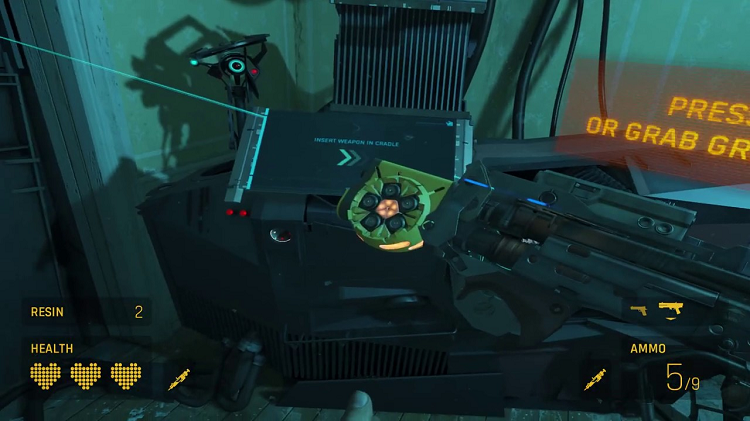
Resin presents as this game’s currency for upgrades. They’re small blocks of glowing material that are hidden throughout the level, and considering Half-Life: Alyx’s detailed world, it’s great fun to go hunting for them! Searching for Resin was a great post-game activity, and prompted me to examine the details of Valve’s beautifully crafted world in all its detail.
To Resin, you’ll need to approach one of the many upgrade stations dotted about the world. These machines require your weapon to be inserted, and from there, you’re presented with a menu enabling you to choose from a range of upgrades for the given weapon.
Each upgrade will cost you a different amount of resin, and you’ll need to choose wisely: there’s no going back once you’ve made your choice, so consider what weapon upgrades will benefit your playstyle and strategy the most.
Enemies
The game features a variety of both new and old enemies and, more so than most games, your approach will require a great degree of specificity for dealing with each.
Head Crabs
The bane of Gordon’s vent crawling, the head crab is back in all its glory. One of the most invasive species that portaled to earth following the Black Mesa incident, head crabs are small, relatively quick, four-legged creatures that pounce at the player when in range.
They’re most efficiently dealt with with a couple of shots of the pistol, or a well-positioned shot to a nearby explosive barrel.
Toxic Head Crabs
A black-colored head crab variant that poisons the player with a substance that gradually reduces their health.
Zombies
Zombies represent the ultimate fate of a head crab’s successful attack. Once human, these creatures have been infected, killed, and taken over as a host for the head crab that sits atop. They’re slow, bumbling enemies but can be dangerous in numbers. Keep your distance and attack at range.
Ant Lion
Huge, ant-type creatures that are highly dangerous. They attack in large numbers both from the air and on the ground. They’re extremely fast and present as one of the toughest enemies to deal with due to their disorientating attacks.
Blue Ant Lion
An Ant Lion variant distinguished through its blue-colored armor and an ability to launch damaging projectiles from a distance.
Combine Foot Soldier
The combine foot soldiers are the most tactical enemies you’ll encounter throughout the game; they’ll flank the player, throw grenades, pin you down with suppressing fire, and rush you out of cover. Considering their human past, they’re mostly matched to Alyx’s combat abilities.
Heavy Combine Soldier
A close-range variant of the combine soldier — a humanoid powerhouse that is particularly difficult to deal with on account of a hand-held energy shield. This variant is also larger and has thicker armor.
Combine Mini Gunner
These enemies are a slower, but potentially more dangerous variant of the combine soldier. Wielding a minigun and clad in thick, impenetrable armor, you’ll hear these walking tanks before you see them — and when you do, it’s time to get out of the way.
Given their huge amount of damage output, it’s best to tackle this foe from far away, and you’ll need to ensure you’re constantly aware of them. Because of their need to be close to the player to attack them adequately, they’ll continually pursue Alex wherever she resides in cover.
Man Hacks
Manhacks are small, flying robots that attack the player with rapidly spinning razor blades. They usually attack in groups and play on the element of surprise. As such, if you hear their familiar sound — a sequence of beeps and the ominous sound of their rotating weapons — seek them out immediately. Once up close, they will deplete your health rapidly.
Armored Head Crabs
A special variant of head crab new to this game, armored head crabs present a unique challenge. Their thick armor is impenetrable to all weaponry, forcing the player to wait until their underbelly is exposed within the split second before they jump. In this case, a precise, well-placed shot from the pistol will always be the best bet.
Barnacles
Static enemies that sit high on the ceilings of buildings. They drop down an incredibly long tongue to ensnare their enemies and suck them up into their jaws. If you don’t want to waste ammo on them, throw an object onto their tongue to trick them and then slip past.
Bloaters
Green Xen pustules that explode when the player is in close proximity. They let off an audible swelling which alerts the player when they’re going to blow up.
Lightning Dog
One of the tougher, faster, and more tactical enemies in the game, the Lightning Dog requires several shots to take down. It has the ability to cloak itself in a cloud of smoke, and it attacks by firing lightning bolts at the player. Critically, the Lightning Dog can also reanimate corpses and use them to fight.
Main Characters
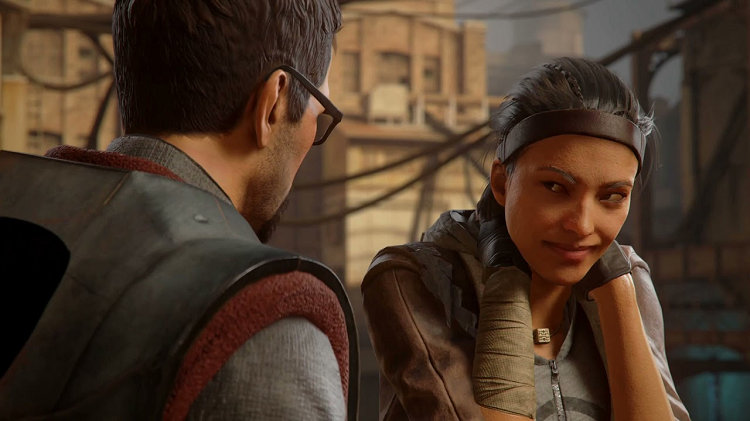
Half-Life: Alyx features a small but great cast of characters, most of which are returning from previous games. Without spoiling anything, here’s some key background information.
Alyx Vance
Alyx is the game’s protagonist, and she was the main character besides Gordon Freeman in Half-Life 2.
She’s only 19 in this game, but don’t let her age fool you: Alyx possesses maturity, ingenuity, and bravery beyond her years; she’s a stubborn, fearless, but thoughtful and kind resistance fighter from the post-combine years on earth, and in this game, she faces an insurmountable task.
Eli Vance
Eli Vance is Alyx’s father and a scientist from the old days of the Black Mesa research facility (the setting of the first game in the series). An old friend of Gordan’s and a partner to fellow scientist Issac Kleiner of Half-Life 2, Eli is another returning character from the second game.
He’s the leader of the resistance against the Combine takeover of City 17, and a key player in the development of the portal technology the invaders are keen to get their hands on.
The Combine
The Combine are the antagonists of the game, and the most frightful thing about them is that they’re a faceless organization. They function by assimilating other beings into their ranks as slaves to carry out their bidding, and as such, no one knows what they actually look like or what alien being sits atop the hierarchy.
The scale of their operation is immeasurable, spanning numerous solar systems and galaxies, and Earth is but one of what is likely thousands of other races that have fallen to their galactic tyranny.
The G-Man
Neither friend nor foe, human nor alien, who or what the G-man remains one of gaming’s biggest questions since his initial appearance in the original game.
As he has in every game, the G-man delivers stilted, uncanny monologues to the player that predict, in essence, events of the past and events of the future. It’s still completely unclear what his main motivations are, but one thing is for sure: he’s incredibly powerful and has the ability to manipulate the very fabric of time and space.
Russel
Russel is the only main character to not have made an appearance in the previous games, but nonetheless, he has been intimately involved with our main characters throughout the series’ timeline — he applied for a job at Black Mesa, for example.
A rather ditsy, somewhat socially inept scientific genius, Russel is a key player on the logistical side of the resistance, operating from his secret lab hidden behind the bookshelf of one of the many dilapidated houses. He’s Alyx’s and the player’s main guide through the game’s innumerable treacherous environments.
Dog
First making an appearance in Half-Life 2, Dog is Alyx’s pet robot. You don’t see a lot of him in this game, but he does make a special appearance.
The Vortigaunts
A benevolent, highly intelligent, English-speaking Alien race. They’re highly instrumental in aiding the resistance, and they’re one of the only beings able to somewhat match the G-man’s power.
Puzzles
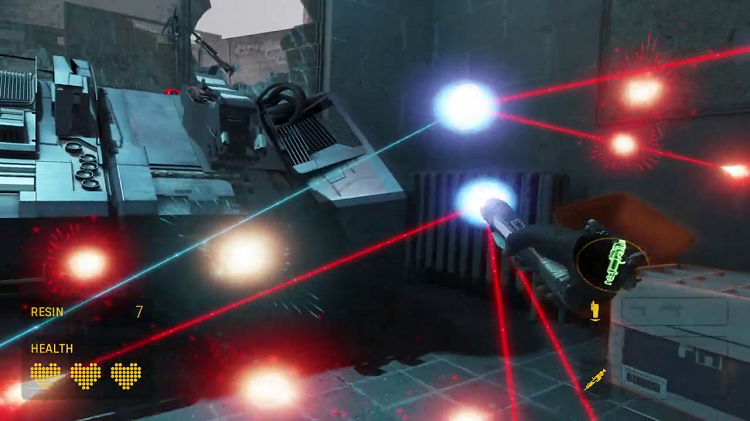
In true series fashion, some of Half-Life: Alyx’s cleverest moments come in the form of its puzzles. There are a few bespoke types that you’ll encounter, but they generally come with a handful of distinct varieties.
Wire Puzzles
These puzzles necessitate scanning the environment’s walls with the multitool to reveal hidden electrical wires, in order to configure them correctly to open a door or gate ahead.
To complete the puzzle, a complete circuit must be made between the power source and the door to be opened: the player controls the flow of electricity by illuminating the hidden wires and then rotating break-points with the multitool.
Rotational Orb Puzzles
These puzzles are usually found on a static object that is locked. To complete them, you’ll need to rotate a globe-like holograph while playing dot-to-dot with a sequence of nodes. These puzzles get increasingly more difficult as you progress through the game.
Pictorial Puzzles
These puzzles utilize subtle features of the environment to convey a puzzle. To delve into these would be to spoil them, but the crucial lesson is to always pay attention to your environment. City 17 is a beautifully detailed game world, and in many cases, the answer to your progression lies in paying attention to it!
Top Tips
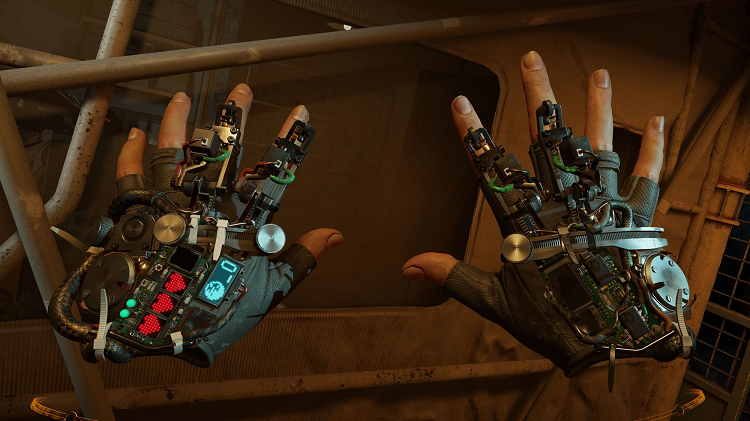
Learning ins and outs of the information above will form the foundation of your proficiency with the game. Here are some general tips that utilize that knowledge:
Take Your Time
While this game is technically an FPS, running in all-guns-blazing won’t get you very far. As well as ensuring to take note of your environment to solve puzzles and find resin, combat situations require a similarly careful approach. Valve has designed the combat to be approached like a chess game, so make sure every shot counts!
If You’Re a Beginner, Start Off Using Teleportation
Full locomotion is usually always too much for newcomers to VR due to nausea it can cause. Don’t sour your experience with the game by making yourself sick with it — stick to teleportation movement until you feel comfortable moving around in the game world.
Wear Headphones/Earphones
More so than most other VR games, Half-Life: Alyx utilizes stereo sound to excellent effect. The solitary, tentative explorations through dingy caves and forgotten dwellings require you to keep your wits about you at all times, and your ears are a very important asset in this regard.
You’ll usually hear your enemies before you see them, so as well as keeping a watchful eye, use headphones to fully immerse yourself in the challenges ahead.
FAQs
The sections above have provided you with a modular overview of the core elements in the game below. To round off, here are a few commonly asked questions.
Question: Do I Need to Have Played the Other Half-Life Games to Enjoy Half-Life: Alyx?
Answer: You can certainly enjoy Half-Life: Alyx without playing the other games in the series, but you’ll definitely want to at least watch a story recap on YouTube if you want to get the most out of the game.
The series has a rich, well written, and well-established lore that you don’t want to miss out on. Besides, the other games are considered some of the best of all time, so checking them out for yourself is a no-brainer regardless! It’s also worth noting that a lot of the jokes and references will only make sense with prior knowledge of the series.
Question: Considering this is the Killer App for the Valve Index, is it Best to Play the Game on that Headset?
Answer: It’s true that Half-Life: Alyx was built with the Index — specifically its knuckles controllers — in mind, but playing on a different headset will not lessen your enjoyment.
The main differences, besides the technical specifications of FOV (field of view) and the LCD, are the controllers. The Index enables you to control all of Alyx’s fingers, whereas something like the Rift S (the HMD I played on) controls the pointer and the other three fingers with two buttons.
Question: I’ve Heard that the Game is Technically Demanding. Might I Have a Subpar Experience Even if my PC only Meets the Minimum Requirements?
Answer: As is always the case, you’re going to have the best experience if your PC meets the recommended settings for the game — but you should still be able to have a great time with the minimum settings.
The game’s detailed world and effects won’t be as striking as you’ll have to keep the graphics settings on the lower side, but this shouldn’t mare your experience. As the old adage goes, graphics aren’t everything — just make sure you meet the minimum system requirements and have fun!
Conclusion
I hope this guide will enrich your experience with the game. Be sure to use it to load up on the required knowledge either before you go in or in-between sessions. For more information and to engage with the community, I recommend joining and participating in the Half-Life: Alyx board on Reddit. Have fun!
Continue reading:
The Walking Dead Saints and Sinners Overview

